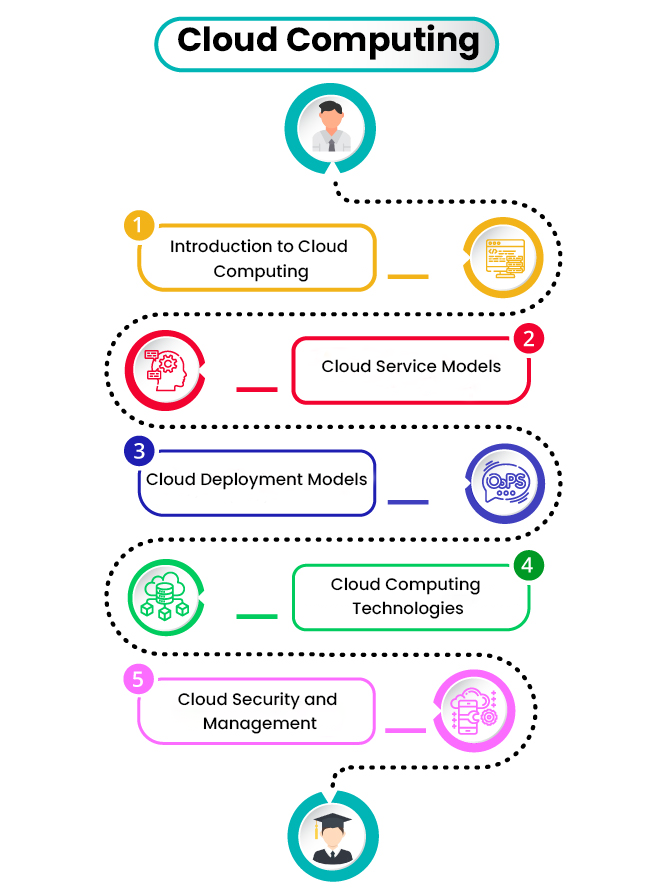Curriculum in Cloud Computing
Linux Fundamentals
Building a Custom Linux Kernel
The GNU/Linux Filesystem
AWS (Amazon Web Services)
Virtual Private Cloud
Load Balancing and Autoscaling
DynamoDB
Introduction to DevOps
DevOps on Cloud
Jenkins – Continuous integration
Docker – A containerization technology
Kubernetes
Microsoft Azure
Azure VMs and Storage Accounts
Create a VM and Storage Account in Azure
Terraform Modules
Terraform With AWS
Curriculum in Cloud Computing
Cloud Computing Is Preferred by Over 35% of Developers. Cloud Computing is the most widely used and in-demand programming language in the IT industry.
- Automating Programs
- Login Options
- Key Filesystem Locations
- BASH – Borne Again Shell
- User Management
- The /proc Pseudo Filesystem
- Software Management
- Hardware Management
- Network Management
- The X Window System
- Kernel Versions
- Kernel Source Files
- Kernel Patch Files
- Kernel Configuration
- Kernel Building
- Testing a New Kernel
- Partition Types
- Filesystem Types
- Mounting
- Automount
- File Types
- File Security
- Introduction to AWS
- EC2
- Storage
- Route 53
- Cloud Front/Content Delivery Network
- IAM
- Relational Database Service
- Monitoring (Cloud Trail & Cloud Watch)
- Application Services
- Design and Architecture
- VPC
- Subnets
- Route Tables
- Internet gateway
- Classic Load balancer
- Application Load balancer
- Network Load balancer
- Scaling through performance
- Server less environment
- Microservices
- DevOps Principles in detail
- DevOps Engineer Skills in the market
- Knowing DevOps Delivery Pipeline
- The market trend of DevOps
- DevOps Technical Challenges
- Tools we use in DevOps
- Essentials of Cloud computing?
- Cloud and virtualization architecture
- Cloud deployment architecture
- Cloud providers – An overview
- Why we need DevOps on Cloud?
- Introducing to Amazon web services
- Essentials of Continuous Integration
- An example scenario where CI is used
- Know about Jenkins and its architecture in detail
- Jenkins tool Management in detail
- Know about User management in Jenkins
- Adding a slave node to Jenkins
- Building Delivery Pipeline
- Notification settings in Jenkins
- Plugin management in Jenkins
- Introduction
- Working with container
- Introduction to Docker Networking
- Docker Swarm – An introduction
- Introduction to Kubernetes
- Kubernetes Cluster Architecture – An overview
- Understanding concepts of Pods, Replica sets, deployments and namespaces
- Understanding the concepts of services and networking
- Persistent volumes and persistent volume claims – an overview
- Design of Pods
- Introduction to Cloud Computing
- Introduction to Azure
- Configuration Management, Automation, and Debugging
- Commands
- Networking in Azure
- Scaling in Azure
- Monitoring in Azure
- High Availability
- Azure AD
- Azure Service Bus Messaging
- Azure Key Vaults
- Web & Mobile Services
- VM Architecture
- Deploy VMs
- Create Storage Accounts for VMs
- Create a VM with Unmanaged Storage
- Manage VM Disks
- Configure Shared Storage
- Clean Up
- Supported Workloads
- Azure CLI
- Azure PowerShell
- Azure Cloud Shell
- VM Agent and Extensions
- ARM Templates
- PowerShell DSC
- Deploy and Enable Debugging for VM in Dev
- Introduction to Modules
- Module repositories
- First Basic Module
- The Module codes
- Main Terraform Code
- Using git repositories to save modules
- Setting up the system for AWS
- AWS Storage: The S3 Bucket and Random ID
- AWS Storage: The Root Module
- AWS Compute: AMI Data, Key Pair, and the File Function
- AWS Compute: The EC2 Instance
- AWS Compute: User Data and Template Files
- AWS Compute: The Root Module
- AWS Networking: VPC, IGW, and Route Tables
- AWS Networking: Subnets, Security, and the Count Attribute
- AWS Networking: The Root Module


.png)
.png)
.png)
.png)

.png)
.png)
.png)
.png)
.png)















.jpg)









